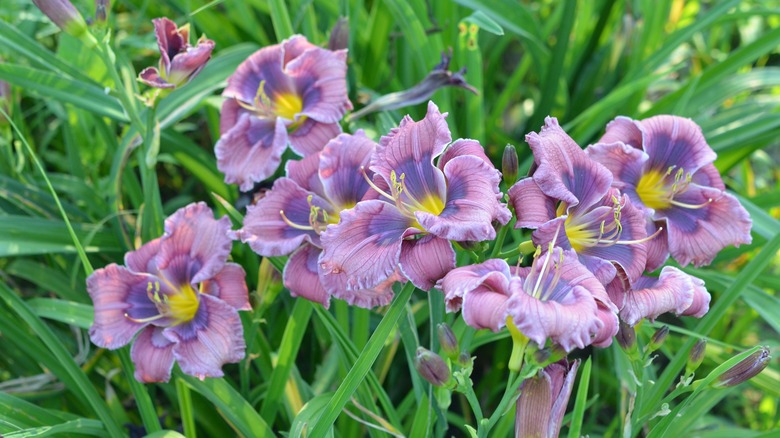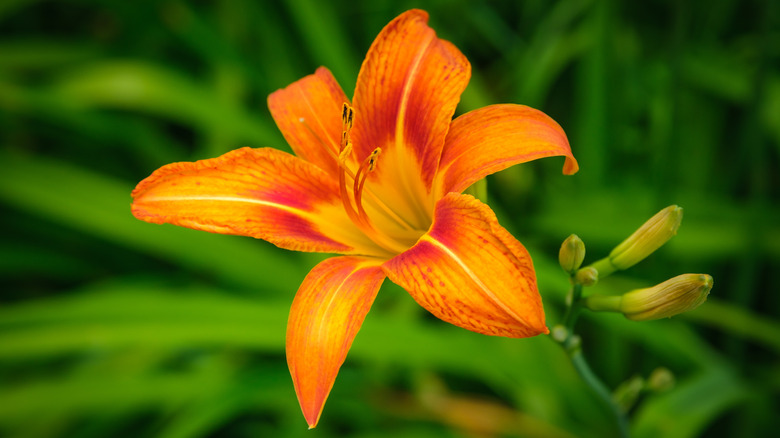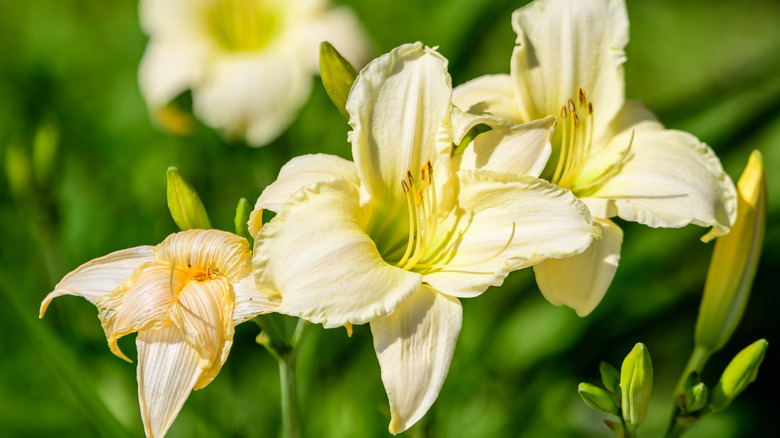How To Prepare Your Daylilies For Colder Weather To Ensure A Thriving Summer Garden
Daylilies are one of the gardener's most reliable friends. They're resilient, easy to care for, provide beautiful flowers throughout the summer, and increase in size every year. But giving them some simple care in the fall ensures they'll continue to thrive. There are several things you can do to help your daylilies before winter sets in, namely cutting back the foliage, adding a layer of mulch, and, if needed, dividing and replanting.
Some daylilies rebloom in late summer, but most of them finish blooming by the end of August. Most gardeners deadhead the spent flower stems to keep the plants looking neat. If you cut back the plant a week or two after it stops flowering, you'll get a tidy clump of foliage that regrows in a couple of weeks. This looks much better than the messy foliage that accumulates at the height of the growing season. This second round of foliage will stay green until the first hard frost. Then, you can cut it back again before winter.
If you opt to not cut back your daylily foliage and leave it all winter, be aware that if the leaves freeze, they may create extra moisture during the spring thaw, and this can lead to some mildew issues in the garden soil. Even just clearing away the dried dead leaves — pulling them away gently with gloved hands — is better than doing nothing.
Mulching your daylilies
Being a cold-hardy perennial, daylilies don't need special protection to make it through the winter. However, a light layer of mulch can help protect the roots in case anything disturbs the soil during the winter, such as burrowing critters like squirrels or frost heaves (which can happen if freezing temperatures follow a hard rain) that may push some plant roots up past the surface. An early hard frost can also damage plant roots if they're exposed, so mulching in the fall is a protective measure just in case.
Daylilies are fairly tolerant of both moisture and dryness, but freezing and thawing of soil throughout the winter can cause stress to perennials. Mulching can help to regulate the surface temperatures of the soil in your garden. You can even mulch in early winter if desired. Putting mulch down a bit late can still help protect your daylilies.
Using a loose mulch that allows for some air flow is a good way to prevent the accumulation of too much moisture or ice near the roots. Many gardeners like to use pine straw or unshredded oak leaves to mulch their flower beds before winter. Shredded pine bark mulch (or pine bark nuggets) is also a good choice. If you have daffodil bulbs planted near your daylilies — a common garden design method, as the daffodil foliage begins to fade as daylilies start to emerge — the mulch will also help protect those first young shoots when they appear in spring.
Should you divide your daylilies in the fall?
Some gardeners like to divide their perennials in the spring, while others prefer autumn. Depending on the plant, one may be a better choice. They are so resilient that daylilies can be divided in either spring or fall. But dividing in the fall means a better chance of not damaging any new growth the plant may already have in spring: this is often a risk when dividing perennials, especially those that form new growth underground in spring, such as hostas.
So go ahead and divide in the fall, but try to do it well before the first hard frost. Dividing your daylilies at this time of year also gives you a head start on planning your garden work for the next season. Maybe you want to make the clumps smaller or move them to a different spot altogether. Moving your daylilies may create some room for some additional spring bulbs or some new perennials to plant in spring.
Autumn garden work is a good time to reflect on the season and remember which plants bloomed simultaneously. Decide if they should be relocated to better enhance your garden design. Maybe you added or noticed something this past season that will inspire you to try a new color combination, like some bright blue perennial geraniums next to some pale yellow daylilies.


